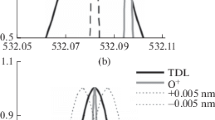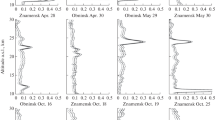Abstract
Results of two-frequency lidar sounding of the atmosphere in the altitude range 25–600 km at the Kamchatka lidar station (52°58′17″ N, 158°15′07″ E) are discussed. The possibility of a manifestation of resonance scattering in the formation of imaginary aerosols in the middle atmosphere is studied. Examples are given where strong scattering at wavelengths of 532.08 and 561.106 nm in the middle atmosphere can be explained by resonance scattering on excited ions of atomic oxygen and nitrogen. These ions may appear as a result of the ionization of the atmosphere by relativistic electrons.




Similar content being viewed by others
REFERENCES
V. V. Bychkov, A. S. Perezhogin, A. S. Perezhogin, B. M. Shevtsov, V. N. Marichev, G. G. Matvienko, A. S. Belov, and A. A. Cheremisin, “Lidar observations of aerosol occurrence in the middle atmosphere of Kamchatka in 2007–2011,” Atmos. Ocean. Opt. 25 (3), 228–235 (2012).
V. V. Bychkov, Y. A. Nepomnyashchiy, A. S. Perezhogin, and B. M. Shevtsov, “Lidar returns from the upper atmosphere and possible causes of their generation,” Atmos. Ocean. Opt. 28 (4), 303–307 (2015).
V. V. Bychkov, A. S. Perezhogin, I. N. Seredkin, and B. M. Shevtsov, “On the role of the method of measuring the background signal in the lidar measurements of the upper atmosphere,” Proc. SPIE—Int. Soc. Opt. Eng. 10466, 1046677 (2017).
V. V. Bychkov and I. N. Seredkin, “Resonance scattering in the thermosphere as an indicator of superthermal electron precipitation,” Atmos. Ocean. Opt. 34 (1), 26–33 (2021).
A. Kramida, Yu. Ralchenko, and J. Reader, NIST ASD TEAM. NIST Atomic Spectra Database (Ver. 5.5.2), National Institute of Standards and Technology, Gaithersburg. https://physics.nist.gov/asd. Cited April 19, 2020.
A. V. El’nikov, V. N. Marichev, K. D. Shelevoi, and D. I. Shelefontyuk, “Laser radar for sensing vertical stratification of atmospheric aerosol,” Opt. Atmos. Okeana 1 (4), 117–123 (1988).
V. V. Bychkov, A. S. Perezhogin, B. M. Shevtsov, V. N. Marichev, P. V. Novikov, and A. A. Cheremisin, “Seasonal features of the appearance of aerosol scattering in the stratosphere and mesosphere of Kamchatka from the results of lidar observations in 2007–2009,” Izv. Atmos. Ocean. Phys. 47 (5), 603–609 (2011).
M. G. Deminov, “Earth’s ionosphere,” in Plasma Heliophysics (Fizmatlit, Moscow, 2008), vol. 2, p. 92–163 [in Russian].
M. G. Deminov and V. V. Khegai, “Analytical approximation of the rate of ionization by auroral electrons,” Geomag. Aeron. 20 (1), 145–147 (1980).
A. Omkhol’t, Polar Auroras (Mir, Moscow, 1974) [in Russian].
M. Picone, A. E. Hedin, and D. Drob, NRLMSISE-00 Model 2001. https://ccmc.gsfc.nasa.gov/modelweb/ atmos/nrlmsise00.html. Cited April 19, 2020.
N. N. Shchefov, A. I. Semenov, and V. Yu. Khomich, Radiation of the Upper Atmosphere as an Indicator of Its Structure and Dynamics (GEOS, Moscow, 2006) [in Russian].
A. V. El’nikov, G. M. Krekov, and V. N. Marichev, “Lidar observations of the stratospheric aerosol layer over Western Siberia,” Izv. Akad. Nauk SSSR. Fiz. Atmos. Okeana 24 (8), 818–823 (1988).
P. B. Russell, T. J. Swissler, and M. P. McCormick, “Methodology for error analysis and simulation of lidar aerosol measurements,” Appl. Opt. 18 (22), 3783–3797 (1979).
P. B. Russell, B. M. Morley, J. M. Livingston, G. W. Grams, and E. M. Patterson, “Aerosol and cloud measurements by an independent-wavelength technique,” Appl. Opt. 21 (9), 1541–1563 (1982).
A. Dm. Danilov, Chemistry of the Ionosphere (Gidrometeoizdat, Leningrad, 1967) [in Russian].
Funding
The work was carried out within the state assignment on the theme (2021–2023) Physical Processes in the System of Near Space and Geospheres under Solar and Lithospheric Impacts. Registration no. АААА-А21-121011290003-0 with the use of equipment of the Collective Use Center of the Institute of Cosmophysical Research and Radio Wave Propagation, Far Eastern Branch, Russian Academy of Sciences, North-Eastern Heliogeophysical Center (SKR_558279, UNU 351757). The work was partly financially supported by the Russian Foundation for Basic Research (grant nos. 19-05-00543 A and 19-5-700008 r_a).
Author information
Authors and Affiliations
Corresponding author
Ethics declarations
The authors declare that they have no conflicts of interest.
Additional information
Translated by O. Ponomareva
Rights and permissions
About this article
Cite this article
Bychkov, V.V., Seredkin, I.N. & Marichev, V.N. Scattering on Excited Ions as a Reason for Detecting Imaginary Aerosols in the Middle Atmosphere. Atmos Ocean Opt 34, 104–110 (2021). https://doi.org/10.1134/S1024856021020032
Received:
Revised:
Accepted:
Published:
Issue Date:
DOI: https://doi.org/10.1134/S1024856021020032




